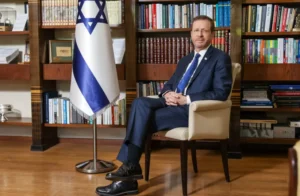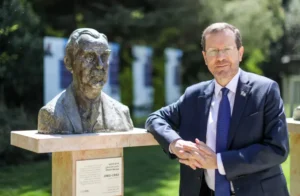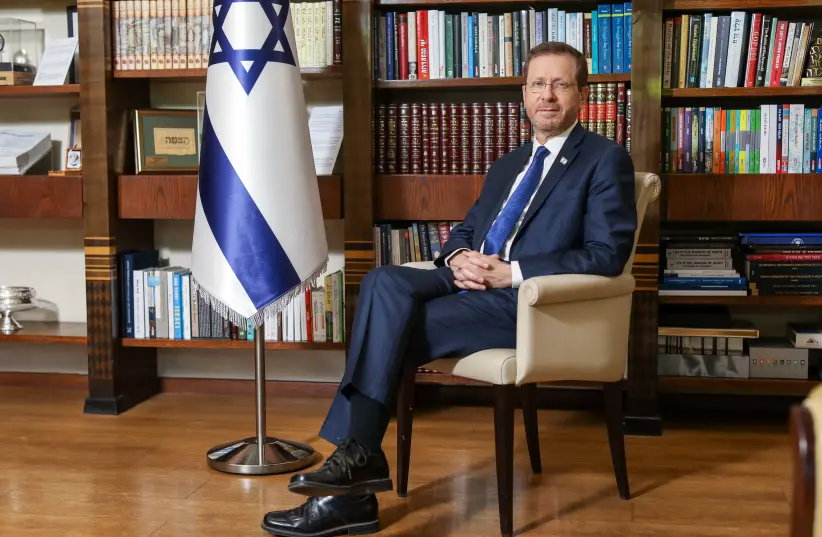Movers and shakers in Israeli society.

COMING FROM an illustrious family, with numerous and diverse accomplishments, President Isaac Herzog is fond of referring to one or two members in relation to events that may parallel any in which his grandparents, parents, siblings, uncles, aunts and cousins may have been involved. On Monday of this week, he would have been unable to avoid such a reference, even if he had wanted to. He and his wife, Michal, toured Herzog Hospital and Rehabilitation Center named for his late grandmother, Rabbanit Sarah Herzog, who served as the hospital’s president for some 40 years before her death in 1979. Founded in 1894 as Ezrat Nashim, the hospital was renamed in the early 1980s to honor the memory of Rabbanit Herzog. Curiously, President Herzog’s immediate predecessor in office, former president Reuven Rivlin, also has a strong family connection with the hospital. His mother was a member of the board for 40 years, and his father was asked to write the history of the hospital on its 75th anniversary.
Herzog and his wife were welcomed by hospital Director-General Dr. Jacob Haviv, President Yehezkel Caine and Chairman Shamai Kenan. Before touring the hospital and its ultra-modern rehabilitation center and inspecting the state-of-the-art equipment which is the latest word in medical technology, the Herzogs met with nurses’ aides who are either going through or who have completed a special course. The aides are all immigrants from Ethiopia, some of whom came to Israel as children, and others who were already adults when they arrived. One who came in 1999 and has worked at Herzog for 11 years, said that she was apprehensive when she started because this was the first time in her life that she had ever set foot in a hospital. But the medical teams were so kind and patient in explaining what needed to be done that they quickly put everyone in the course at ease.
Herzog told the aides that nursing is holy work that has to be approached through love of humanity. He believed that if his grandmother were alive and could see the participants in the course, she would be emotionally excited. It was a very moving experience for him, he said. Toward the conclusion of their visit, the Herzogs signed the Golden Guest Book while standing alongside a large portrait of the president’s grandmother, who Herzog said had dedicated her whole life to helping the needy.

The Zemel family
■ ON THE subject of hospitals, Yocheved and Moshe Zemel cannot speak highly enough about the cardiology department in Hadassah Ein Karem’s Davidson Tower, where Moshe Zemel’s life was saved by a new cardiac procedure. It not only indefinitely delayed his meeting his Maker but also enabled an amazingly speedy recovery. At the conclusion of the Sabbath service in the Pinsker Street Migdal Hashoshanim synagogue on the ground floor of the apartment complex in which they live, Moshe Zemel told congregants about his illness, his treatment and his new lease on life. The man who not so long ago could barely walk, is walking with such a spritely step that he’s almost dancing. This was obvious at the kiddush that he and his wife hosted to celebrate his return to health. He’s lost weight in both his body and his face, which gives him a more youthful appearance. Though in his mid-80s, he looks closer to being in his mid-60s. Due to his illness, he missed out on the wedding of his granddaughter Rena Zemel to Avraham Silverstein but had no intention of missing the wedding of his grandson Yehuda Heigh to Sheindel Gold. The Zemels have produced a very large family, so there are plenty of celebrations along the way.
Hadassah Mount Copus
■ STILL WITH Hadassah but this time the campus on Mount Scopus, there is yet another innovation, the signature naming of a new rehabilitation center equipped to deal with patients recovering from every imaginable kind of ailment, injury and disease. To be named the Gandel Rehabilitation Center, it is scheduled to open in early 2023 but will officially be named on Monday, August 8. The construction of this facility has been made possible by a gift from the Gandel Foundation headed by mega philanthropists John and Pauline Gandel from Melbourne, Australia. Through Hadassah Australia and Hadassah International, the Gandel Foundation gifted the Hadassah Medical Organization with $20 million, which is the largest ever single donation received by Hadassah that, taking into account the sprawling, high-rise Hadassah campuses on Mount Scopus and in Ein Karem is difficult to believe, but nonetheless true. Over the years there have been many big donors to Hadassah projects, but no single donor has matched the Gandels’ generosity. Hadassah Australia President Ron Finkel has described the Gandels’ gift as “transformative” and said that it is designed to help the people of Jerusalem. Actually, it will help people from all over the country and possibly from the Palestinian Authority, Gaza and Syria. Patients from these places are treated in Israeli hospitals, including Hadassah, so it stands to reason that they will also be restored to health at the Gandel Rehabilitation Center. In giving away millions of dollars for projects in Australia and Israel, the Gandels are guided by one major consideration, which is creating a significant positive difference in people’s lives.
Long-time supporters of education in Israel, the Gandels have also been heavily involved with projects of the Hebrew University in Jerusalem and Tel Aviv University.
In Australia, they have made grants available to scores of Jewish and non-Jewish organizations and institutions with projects geared to health, education, culture, the arts, social welfare, human rights, leadership, Jewish identity and more.
Benches in Jerusalem
■ ONE CAN’T help wondering whether the Jerusalem Municipality received a massive donation of outdoor chairs and benches, which can increasingly be seen on sidewalks all over the city. While Mayor Moshe Lion is to be commended for providing this kind comfort for residents and visitors who can rest and relax while going on long walks, particularly on Shabbat, very few of these seats are in proximity of a drinking fountain or a public toilet. There is no point in having this mass seating accommodation in this unbelievably hot weather if one can’t drink from a street fountain and wash the perspiration from one’s face. Most of us are conscious of developments in our own neighborhoods and along routes that we travel fairly frequently. But a shock awaits people who rarely travel outside their orbit only to learn that many former landmarks have disappeared and have been replaced by high-rise residential complexes. Veteran immigrants, whose first home in Israel was the Beit Giora immigrants absorption center in Kiryat Hayovel, which is now a home for lone soldiers, will find that the surrounds are now completely different.
Under the Lion administration, all the quaintness for which Jerusalem was known is rapidly disappearing to be replaced by a Middle East version of Hong Kong.
At ground level, the municipality is running a bike lane pilot project on the road and not the pavement in which a section of the road closest to the pavement is painted vivid green and is supposed to be reserved only for bicycles. But the green streak suddenly stops, which means that cyclists who stay on the road take their lives in their hands, and those who find their way to the pavement, once again annoy pedestrians.
Conventional wisdom characterizes a camel as a horse designed by a committee. The more one looks around, the more one realizes that Jerusalem is a camel capital.

